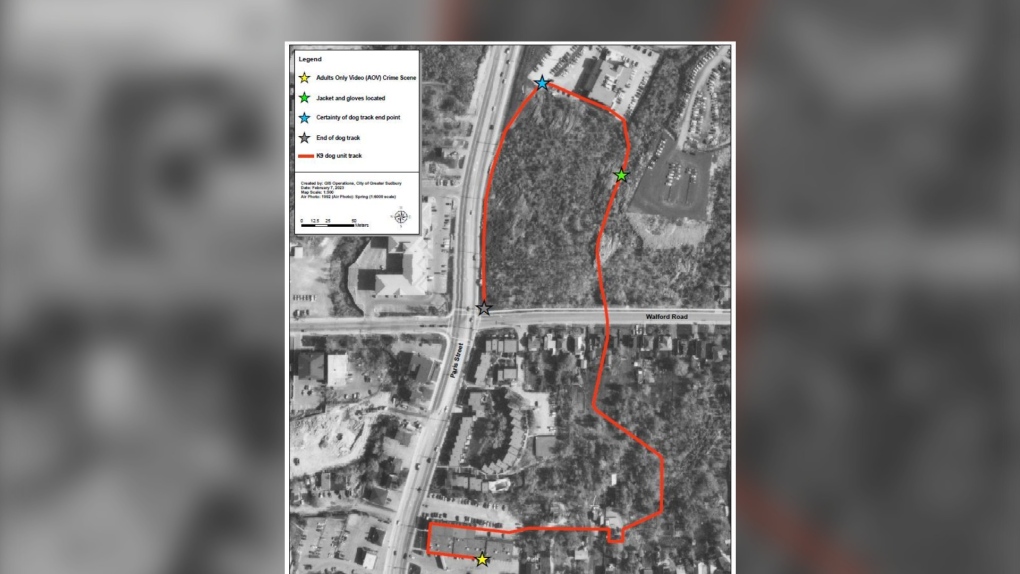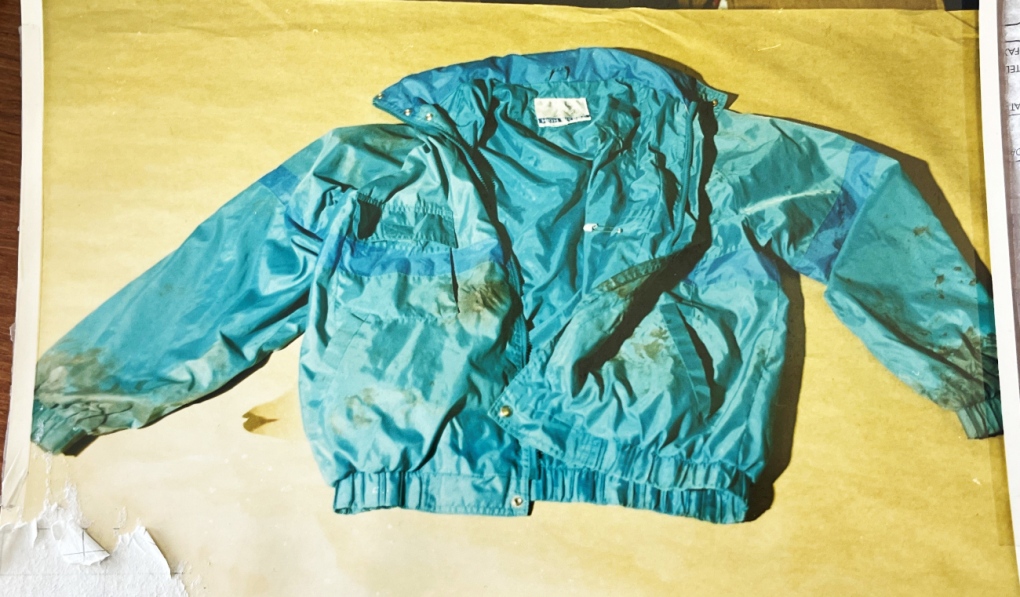Testimony at Robert Steven Wright trial focuses on first murder suspect, canine track
The first person charged with the murder of Renee Sweeney in Sudbury was the spotlight Tuesday at the trial of Robert Steven Wright.
Wright is charged with second-degree murder in Sweeney’s Jan. 27, 1998, death. But a suspect named John Fetterly was charged first with the murder in February 1998 -- charges that were later dropped.
Testifying in the afternoon was Robert Keetch. The former chief of police in Sault Ste. Marie was a sergeant in Sudbury in 1998 and the lead investigator in the Sweeney case.
Defence attorney Michael Lacy asked Keetch about Ray Hutchison, who worked in a computer store at the Paris Street strip mall where the murder took place.
Hutchison told police he saw someone enter the adult video store where Sweeney worked at 11 a.m.
Court heard that Hutchison had been interviewed twice and picked someone out of a bunch of photos. Then a photo of Fetterly was shown taken the day of his arrest on Feb. 10, 1998.
Keetch confirmed it was him.
Lacy reviewed Fetterly’s criminal record, which included break and enters beginning in 1983, theft and extortion charges in 1986 and assault convictions, the last being in 1994 in Sudbury.
At the time, Fetterly was living with his mother on Riverside Drive, about 3.6 kilometres from where the murder took place. Police obtained a search warrant for the residence.
Lacy also referred to a community mental health worker named Pierre Rivers who had dealt with Fetterly in the past. In his interview with Sudbury police in 1998, Rivers told them Fetterly was interested in knives.
“He likes to talk about weapons,” Rivers said in his interview with police.
“Especially knives.”
Once when he came in, Rivers said Fetterly showed him and another social worker a knife he was carrying that had a four- to six-inch blade.
“I told him weapons are not allowed in the centre,” Rivers told police.
Crown attorney Rob Parsons asked Keetch whether there was any talk of Fetterly doing anything other than talking about knives.
Keetch said "no" and that he was unaware of Fetterly ever threatening to use a knife.
 Former Sudbury Police officer Brian McRury led the canine track the morning of Sweeney’s murder, shown in this image from the trial. Mcrury said his dog, a German shepherd named ‘Oakey,’ was trained to track human scents. (Supplied)
Former Sudbury Police officer Brian McRury led the canine track the morning of Sweeney’s murder, shown in this image from the trial. Mcrury said his dog, a German shepherd named ‘Oakey,’ was trained to track human scents. (Supplied)
The last witness of the day was Brian MacRury, who spent 27 years with the Sudbury police, much of that time as a canine track officer.
McRury led the canine track the morning of Sweeney’s murder. He said his dog, a German shepherd named ‘Oakey,’ was trained to track human scents.
It’s key to find tracks in less travelled areas, McRury said, so the scent isn’t mixed in with other humans, something that would confuse the dog.
He said it’s easiest to track people through places like forests, with asphalt areas the toughest because they are so busy and there are so many competing scents. It’s tougher in winter, too, he said, because the air is dry and people are bundled up.
However, McRury said he and Oakey had experience tracking in winter conditions.
“He was a very, very successful dog,” he said, of Oakey’s ability to track a specific human’s scent.
McRury and Oakey arrived at the crime scene at 12:17 p.m. that day. It was vital to find an area “where only the suspect would have been,” he said, so Oakey could zone in on the specific scent and then follow it along.
They were told the suspect headed north on Paris Street. At 12:36 p.m., the track began.
Eventually, McRury located a single set of footprints in the snow behind the mall leading into the bush.
 This is photo of the stained teal jacket that Brian McRury and his canine Oakey discovered during the track on Jan. 27, 1998. (Supplied)
This is photo of the stained teal jacket that Brian McRury and his canine Oakey discovered during the track on Jan. 27, 1998. (Supplied)
McRury said the footprints were five to six feet apart, indicating the person was running, and were headed northeast. The pair headed through deep, fresh snow and came to a fence where it looked like someone had climbed over.
Oakey had a strong hold on the scent, McRury said.
“He was pulling hard. Head down, no hesitation,” he said.
Eventually, they came across the stained teal jacket that police believe was connected to the case. It was stuffed into some rocks.
“It appeared to be a rolled up, crinkled-up nylon jacket,” McRury said. “It had been pushed in there.”
Another officer stayed behind to guard the evidence as McRury and Oakey continued the track, but soon the dog lost the scent.
Despite their best efforts, “we never, ever acquired the scent again,” he said.
The track ended at 1:08 p.m.
The trial resumes Wednesday morning when the defence is expected to cross-examine McRury.
Background
The brutal stabbing death of 23-year-old Renee Sweeney rocked the City of Sudbury to its core on Jan. 27, 1998.
Police searched for her killer for two decades and finally charged Robert Steven Wright, who was 18 years old at the time of the murder. He has been held in jail since his arrest in Dec. 2018.
After several delays, the trial began Feb. 21, 2023, just after the 25th anniversary of Sweeney's death.
CTV News Digital content producer Darren MacDonald is bringing the latest from the courtroom every day and will have full coverage of the trial here.
CTVNews.ca Top Stories

Immigrants take to the streets to protest against the freezing of immigration programmes
In response to the freeze on immigration programmes announced by Ottawa, an organization that defends the rights of immigrants is organising a demonstration in front of the Montreal office of the Quebec Ministry of Immigration, Francisation and Integration early on Saturday afternoon.
Muskoka reacts to major snowfall, Highway 11 still closed
From road closures, power outages, weather declarations and nonstop shovelling, Muskoka residents were faced with nearly a metre of persistent snowfall on Saturday.
Beef prices reach record highs in Canada
The cost of beef continues to rise, reaching record highs on grocery store shelves ahead of the busiest time for many grocers and butchers before the holiday season.
A man hid 5 treasure chests worth more than US$2 million across the United States. Here’s how to find them
Inside the chests, searchers can look forward to hopefully locating items such as rare Pokémon cards, shipwreck bounty, sports memorabilia, gold and precious medals.
Pedestrian killed by Via Rail train near Kingston, Ont.
Regular rail traffic has resumed with severe delays.
Shopping on Shein and Temu for holiday gifts? You're not the only one.
Welcome to the new online world of impulse buying, a place of guilty pleasures where the selection is vast, every day is Cyber Monday, and an instant dopamine hit that will have faded by the time your package arrives is always just a click away.
Bail and promises of justice: The case of Canadians Daniel Langlois and Dominique Marchand murdered in Dominica
A year has passed since Canadians Daniel Langlois and Dominique Marchand were found dead in a burned-out car in Dominica, and there has yet to be justice for the philanthropists who were beloved by many on the island.
Canadian team told Trump's tariffs unavoidable right now, but solutions on the table in surprise Mar-a-Lago meeting
During a surprise dinner at Mar-a-Lago, representatives of the federal government were told U.S. tariffs from the incoming Donald Trump administration cannot be avoided in the immediate term, two government sources tell CTV News.
'We're going to be very visible': Minister Champagne on border plan amid Trump's tariff threat
Industry Minister François-Philippe Champagne says the Canadian presence at the border it shares with the U.S. will be “very visible” in response to U.S. president-elect Donald Trump’s recent tariff threats.

































